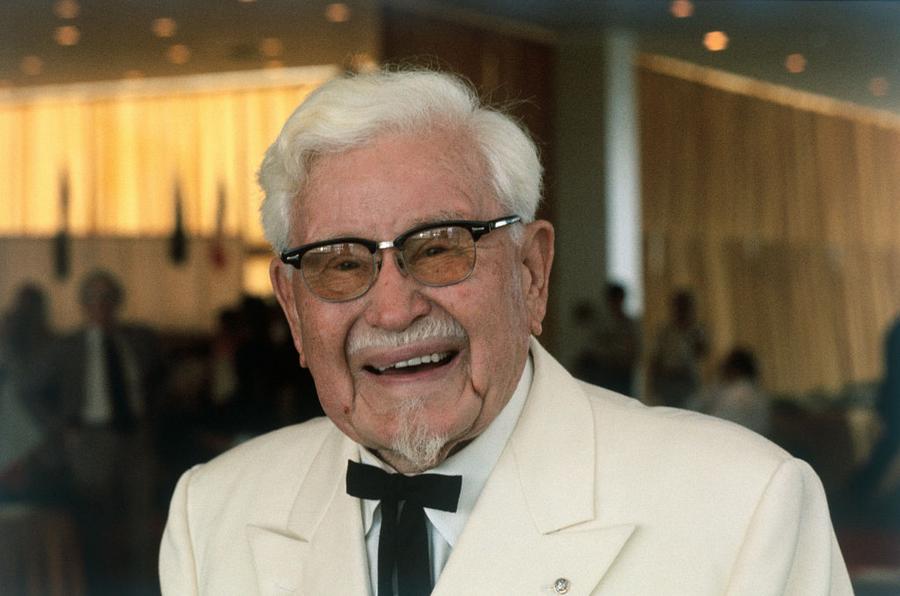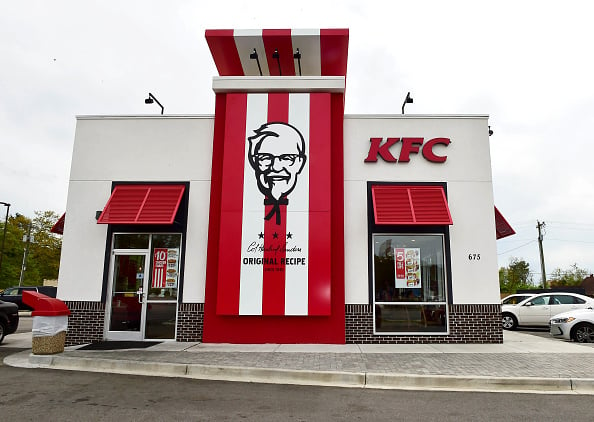What was Colonel Sanders's Net Worth?
Colonel Sanders was an American businessman and entrepreneur, best known as the founder and face of the fast food restaurant chain Kentucky Fried Chicken. At the time of his death, Colonel Sanders' net worth was $3.5 million. That's the same as around $10 million today after adjusting for inflation. Perhaps not as much as you'd guess considering the fact that today KFC's annual revenue tops $23 BILLION.
Also known as Harland Sanders, he died on December 16, 1980 at the age of 90. He also served as KFC's brand ambassador and symbol. He did not serve in the military but earned an honorary title of a Kentucky Colonel. He founded KFC during the Great Depression and developed his secret recipe and method for cooking chicken in a pressure fryer. He focused on franchising his chicken throughout the U.S. In 1964 Sanders sold the company to investors for $2 million. He was 73 years old at the time. That's the same as around $15 million today after adjusting for inflation. He stayed on as a brand ambassador and retained control of operations in Canada.
Early Life
Harland Sanders was born on September 9, 1890 in Henryville, Indiana as the eldest of three children of Margaret and Wilbur. Raised in a strict Christian household, he attended the Advent Christian Church with his family. After Sanders's father died in 1895, his mother began working at a tomato cannery while he looked after his siblings. By the time he was seven, Sanders had reportedly become skilled at cooking vegetables. In 1902, his mother remarried to William Broaddus, and the family moved to Greenwood, Indiana. The following year, Sanders dropped out of school and went to live and work on a farm nearby. He then took a job painting horse carriages in Indianapolis. At the age of 14, Sanders worked as a farmhand in southern Indiana.
Career Beginnings
In 1906, Sanders went to New Albany, Indiana to live with his uncle, who worked for a streetcar company. There, he got a job as a conductor. Sanders went on to enlist in the US Army by falsifying his date of birth; he served as a wagoner in Cuba before being honorably discharged in early 1907. Sanders then moved to Sheffield, Alabama, where his uncle was now working for the Southern Railway. His uncle helped get him a job as a blacksmith's assistant. About two months later, Sanders moved to Jasper, Alabama, where he landed a job cleaning out ash pans from Northern Alabama Railroad trains. He soon progressed to the position of steam engine stoker, which he did for close to three years. Still on the railroad, Sanders became a laborer with the Norfolk and Western Railway in 1909. After that, he became a steam engine stoker on the Illinois Central Railroad.
Odd Jobs
While working on the railroad, Sanders studied law by correspondence through La Salle Extension University. He later began to practice law in Little Rock, Arkansas, although his legal career ended after three years when he got into a courtroom brawl with his client. Due to that incident, Sanders was forced to move back in with his mother in Henryville, Indiana. He subsequently worked on the Pennsylvania Railroad. After the family moved to Jeffersonville, Indiana, Sanders landed a job selling life insurance for Prudential. He was eventually fired from that job due to insubordination. Sanders subsequently got a sales job with Mutual Benefit Life. In 1920, he established a ferry boat company that operated a boat on the Ohio River between Jeffersonville and Louisville. A couple years later, he became secretary at the Chamber of Commerce in Columbus, Indiana. After resigning within a year, Sanders cashed in his ferry boat company shares and established a business manufacturing acetylene lamps. However, the business failed. Sanders went on to work as a salesman for the Michelin Tire Company in Winchester, Kentucky.

Founder of Kentucky Fried Chicken, Colonel Harland Sanders. (via Getty)
Kentucky Fried Chicken
In 1924, Sanders met the general manager of Standard Oil of Kentucky, who invited him to run a service station in Nicholasville. He did so until the station closed in 1930 amid the Great Depression. Subsequently, Sanders was offered his own service station in North Corbin, Kentucky by the Shell Oil Company; he was given the station rent free in return for paying Shell a percentage of his sales. From the roadside stop, which eventually added a restaurant, Sanders began serving chicken dishes and various other meals. In 1935, he was commissioned as a Kentucky Colonel. Sanders's local popularity grew over the years. Although his North Corbin restaurant burned down in 1939, he rebuilt it in Asheville, North Carolina as a restaurant and motel combo. By the summer of 1940, Sanders had perfected his "secret" recipe using a pressure fryer to cook chicken. When tourism declined during World War II in late 1941, he was forced to close his Asheville location. Sanders then worked briefly in Seattle before working in cafeterias in Tennessee.
In 1950, Sanders was recommissioned as a Kentucky Colonel. Two years later, he franchised his "secret" Kentucky Fried Chicken recipe for the first time, to restaurant operator Pete Harman of South Salt Lake, Utah. The recipe was a massive hit, resulting in sales at Harman's restaurant more than tripling within just one year. Due to that success, Sanders franchised his recipe to several other restaurant owners. He went on to franchise his fried chicken throughout the country, as well as internationally in countries such as Canada, Mexico, Australia, and the UK. In 1963, he trademarked the slogan "It's Finger Lickin' Good." By the next year, KFC had expanded to over 600 locations, making operations overwhelming for Sanders. Consequently, he sold the company to a group of investors for $2 million. Sanders retained control of operations in Canada, and became a salaried brand ambassador. He would go on to serve as the face of KFC in television commercials and other ads, with his white suit, white hair, and bleached mustache and goatee becoming symbolic of the brand.

Getty
Later Years
Later in his life, Sanders became highly critical of the changes KFC made to its food in attempts to cut time and costs. In the 1970s, he often made surprise visits to KFC restaurants, and if he was underwhelmed by the food, he would deride the franchisee as "goddamned slop" and push the food onto the floor. Sanders publicly described the company's gravy at the time as "sludge." In response to his disappointment, he and his wife opened a restaurant serving KFC-style chicken as part of a full-service dinner menu. However, Sanders sold the restaurant after being sued by the parent company of KFC, Heublein. The restaurant continued to operate, and today is the only non-KFC restaurant to serve an authorized version of Sanders's fried chicken recipe.
Personal Life and Death
In 1909, Sanders married his first wife, Josephine King. They had three children together: Margaret, Harland Jr., and Mildred. During the marriage, Sanders had an affair with Claudia Ledington-Price, whom he went on to marry in 1949 after getting divorced from King.
In mid-1980, Sanders was diagnosed with leukemia. He passed away at the end of the year from pneumonia, at the age of 90. Sanders was buried in his signature white suit and black string tie in Cave Hill Cemetery in Louisville, Kentucky.
/2020/08/colonel-sanders-1.jpg)
/2020/03/phyllis-george.jpg)
/2011/11/wendy-thoms2.jpg)
/2020/09/John-Pierpont-Morgan.jpg)
/2014/12/GettyImages-476488376.jpg)
/2018/03/Dave-Thomas.jpg)
/2022/01/Jane-Birkin.jpg)
/2021/02/barry-sanders.jpg)
/2010/02/Jennifer-Hudson.jpg)
/2019/10/Paulina-Porizkova.jpg)
/2012/07/GettyImages-508683722.jpg)
/2009/10/Peyton-Manning-1.jpg)
/2021/03/ben.jpg)
/2020/01/akon2-1.jpg)
/2020/01/Patrick-Duffy.jpg)
/2012/09/Delta-Goodrem.jpg)
/2012/08/Archie-Manning.jpg)
/2020/08/colonel-sanders-1.jpg)
/2018/03/Dave-Thomas.jpg)
/2015/08/kfv.jpg)
/2016/09/GettyImages-478430337-e1514321257435.jpg)
/2015/10/bernard-marcus.jpg)
/2020/03/phyllis-george.jpg)
/2011/11/wendy-thoms2.jpg)
/2010/09/Thomas-Keller.jpg)